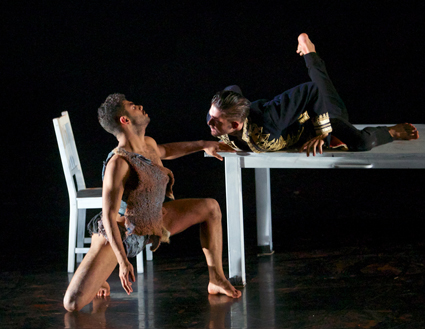The strengths & limits of form
Erin Brannigan: Bangarra Dance Theatre, Clan 3

Daniel Riley, Beau Dean Riley Smith, Macq, Dance Clan 3, Bangarra
photo Greg Barrett
Daniel Riley, Beau Dean Riley Smith, Macq, Dance Clan 3, Bangarra
Dance Clan 3, presented in the Bangarra studio at Pier 4, featured works by four female artists from the company: Tara Gower’s Nala, Jasmin Sheppard’s Macq, Deborah Brown’s Dive and Yolande Brown’s Imprint. Artistic Director Stephen Page has to be commended for continuing to support the choreographic development of Bangarra artists—and female at that—in a way unsurpassed by their counterpart Sydney Dance Company but perhaps matched nationally by Gideon Obarzanek, Lucy Guerin and Kate Champion.
Comprising three dance works (and the film Dive) it seems odd that the casts in Dance Clan 3 are all so large. While it’s true that there are few opportunities to work this way in Australian dance productions due to funding restrictions, I enjoyed the smaller group work within the pieces more. Managing a large ensemble is a very specific skill that artists have little opportunity to develop here and is a big ask of first-time choreographers. Artists like Bonachela, Tankard and Healey have gained experience through a commitment to this particular format and ample opportunities.
Dance theatre is the preferred mode at Bangarra, which Page is upfront about, referring in his program notes to the company’s “theatrical story-telling.” These women have stories to tell about the trauma of genocide, the fight for land rights and the struggles involved in negotiating the social and financial changes brought about by “imposed progress” (Gower). So much of the content of these works is historical as opposed to the work of peers such as Vicki van Hout who deal very much with the contemporary Indigenous condition.
This produced some resemblances that startled me: a scene in Sheppard’s Macq represents the power struggle between the Indigenous population and Governor Macquarie (with a voice-over quoting from the latter’s diary), one dancer representing an Indigenous man and the other the Governor, stalking each other on and around a long table. The resonance with German choreographer Kurt Joos’ Green Table of 1932—an anti-war statement made just prior to Hitler’s rise to power—was there in Sheppard’s archetypes and political content writ large.
Gower’s Nala was full of characters and relationships, past bleeding into present and traditional crossing over with the modern. Beginning with a scene in a cinema and covering much territory, this piece seemed to focus more on choreographic novelty as opposed to important stories.
The movement language never strayed too far from Stephen Page’s: the signature floor work (pulling forward on the belly with strong arms with legs curling up and behind with flexed feet); jumps that hit the air in striking shapes; and partner work that entwined and unravelled with slippery precision. Composing large groups of dancers through patterning and breaking into smaller group work was also evident.
This made me wonder about the breadth of exposure these accomplished choreographers are experiencing. Given the long history of Africanist fusions with French contemporary dance and the multiplicity of traditional forms now blending with each other as well as with Western modalities, the storytelling tradition so important to these artists could be fed by such intercultural innovations at the level of movement invention. The qualities and techniques of the various indigenous traditions are so distinct and sophisticated, there will be many new ways to draw out what the forms have to offer contemporary dance.
This potential was in evidence in some innovations when the demands of storytelling allowed space for the movement to become the medium. Gower’s Nala threaded some traditional yet playful percussive sequences successfully in her narrative, and Sheppard’s section Bodies in the Trees (referring to Macquarie’s directive to hang the Indigenous dead in the trees as a warning to others) featured a moving cascade of male bodies passed down on a simple set of steps.
–
Bangarra Dance Theatre, Clan 3, artistic director Stephen Page, choreographers Deborah Brown, Yolande Brown, Tara Gower, Jasmin Sheppard, music David Page, set design Jacob Nash, costumes Jennifer Irwin, lighting Matt Cox, Bangarra Studio Theatre, Pier 4, Sydney, 20 Nov-1 Dec, 2013
RealTime issue #119 Feb-March 2014 pg. 26






